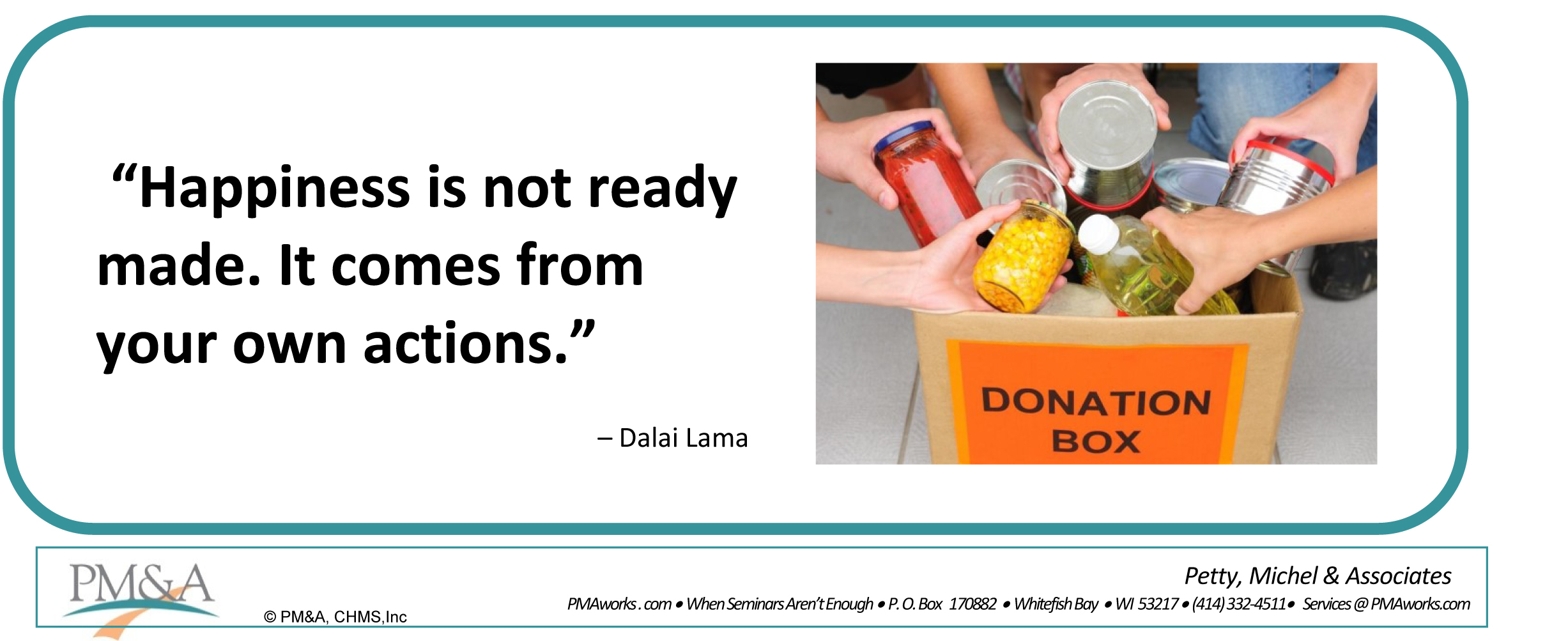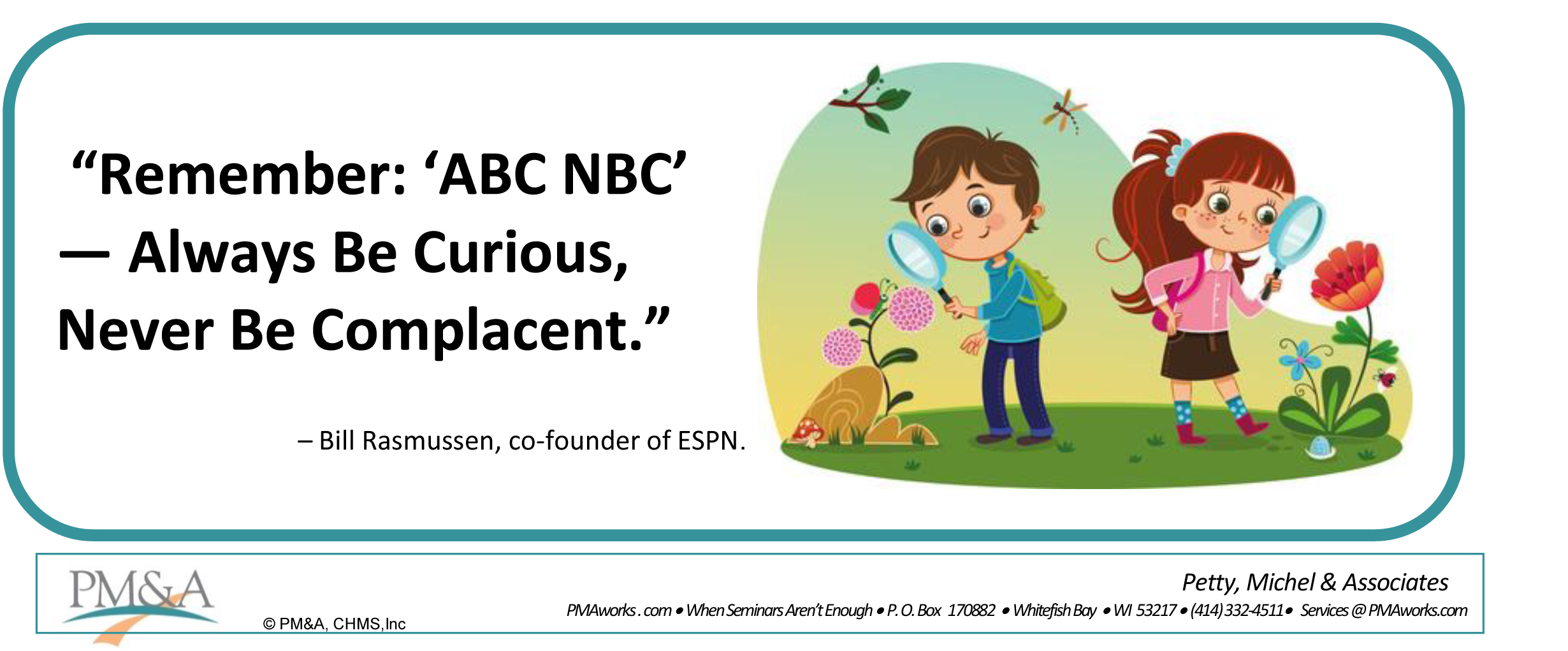“It’s kind of silly and fun, but I think that silly and fun things are important.”
~Elon Musk
For a printable copy of this tent poster email us.

“It’s kind of silly and fun, but I think that silly and fun things are important.”
~Elon Musk
For a printable copy of this tent poster email us.
“Wisdom frees us from doubt, virtue frees us from suffering, resolution frees us from fear.”
~Confucius

For a printable copy of this tent poster click: Confucius Virtue
“A merry heart doeth good like a medicine…”
~Proverb 17:22, Bible

For a printable copy of this tent poster visit: A merry heart.. proverbs
“Man’s search for meaning is the primary motivation in his life…”
~Viktor E Frankl, MD, PhD
For a printable copy of this tent poster email us.
“Happiness is not ready made. It comes from your own actions.”
~Dalai Lama

For a printable copy of this tent poster visit dalai lama happiness.
“Remember: ‘ABC NBC’ -Always be Curious, Never be Complacent.”
~Bill Rasmussen, co-founder of ESPN.
To download a printable copy pf this tent poster, click the link. ABC NBC Curious – Complacent
November and December are special times for patient marketing, whether you are promoting to prospective patients, active, or inactive patients.
Usually, we have found that internal marketing is better during this time of year as you don’t need to compete with commercial businesses as they slug it out in an advertising frenzy. You can prepare now and schedule your external promotions and community services for January and February. Of course, if you see an excellent opportunity for external marketing now, take it. But the primary focus should be internal for these two months.
November and December are “cozy” months. In North America — we have Thanksgiving. This is a time we give thanks for all our blessings and gifts and family and friends. It is a time when people feel grateful. Christmas is also a time of good cheer and giving, as is Hanukkah and other holidays.
And, for some of you, it is also the season of the yearly hunt — when you bring home the ring tail pheasants, the turkeys, and “da ‘tirty point buck.” (Wisconsin-ese for “the 30-point buck.”)
Your promotions should align with the spirit of the season to be most effective. Donation drives are often held. There are many churches and associations in your town that need help as they prepare to assist the less fortunate.
“Toys for Tots”, “Food for Families”, or “Coats for Kids”, are many popular promotions by local media stations. I don’t doubt that they are helpful, but I do sometimes question their sincerity.
Of course, you want more customers, that is the nature of business. But you must lead with your mission statement first.
Any promotions should stem from your higher purposes.
The Higher Purpose Company
In The High Purpose Company, (Arena, 2007) Christina Arena reports on her team’s study of 75 companies’ efforts at Corporate Social Responsibility (CSR).
She shows how corporations, by doing good, by providing better conditions for employees, more sustainable sourcing of raw materials, and contributing to beneficial causes in their communities, generate more income.
“The central findings of my research can be distilled in the following way: superficiality fails whereas authenticity prevails. Companies that falsely approach corporate responsibility as a form of marketing, public relations, or even philanthropy don’t produce the most meaningful results. In fact, they often waste their money and create additional liabilities. Conversely, companies that truly approach the practice of corporate responsibility as a fully integrated business strategy, wisely investing in profitable solutions to meet unmet social and environmental needs and problems find their performance greatly enhanced.”
According to the Harvard Business Review, business spent more than $15 billion in 2016 on Corporate Social Responsibility (CSR) programs. (Davidson, July 7, 2016) And according to, Linda Novick O’Keefe, founder of Common Threads, “that number is rising as businesses see signs that investments in CSR improve company performance, talent recruitment and retention. (O’Keefe, 2016) “Giving in Numbers”, a study published by the CECP that analyzes giving and corporate societal engagement trends, revealed companies that increased giving by at least 10 percent between 2013 and 2015 actually experienced upticks in revenue and pre-tax profit, while all other companies saw a decrease in both.”
Your “WHY?”
Marketing must be honest, and it has to tell why you are doing the marketing. As Simon Sinek reminds us:
“Very few people or companies can clearly articulate WHY they do WHAT they do. By WHY I mean your purpose, cause or belief – WHY does your company exist? WHY do you get out of bed every morning? And WHY should anyone care?
People don’t buy WHAT you do, they buy WHY you do it.
All organizations start with WHY, but only the great ones keep their WHY clear year after year.” (Sinek, 2009)
I recommend finding charities or causes in your community that your patients care about. That you care about. Then, go talk to the head of the charity yourself – get involved – personally. Emotionally.
One office paid their staff for one hour for every two hours they went out of the office and worked on a community project.
And it doesn’t have to be charities. A Kid’s Day with “Saturday with Santa” can be a ball. One office holds a patient appreciation party with their patients each December with a Christmas Elvis impersonator singing Christmas carols. The one I attended was packed, and a little wild. But everyone talks about it for the rest of the year.
Your patients, and your neighbors, want what you want – a better and healthier community. Communicate that in all your promotions and you’ll get better results, and have more fun.
And, many thanks for you do from all of us at PM&A!
Ed
A list of sample promotions on our web site – see reference below.
References
Arena, C. (2007). The High Purpose Company. Harper Collins.
Davidson, R. H. (July 7, 2016). CEO Materialism and Corporate Social Responsibility. Harvard Law School Forum on Corporate Governance and Financial Regulation. Retrieved from https://corpgov.law.harvard.edu/2016/07/07/ceo-materialism-and-corporate-social-responsibility/
O’Keefe, L. N. (2016, Decembr 15). CSR Grows in 2016 as Companies Embrace Employees’ Values. Huffington Post – The Blog. Retrieved from https://www.huffingtonpost.com/linda-novick-okeefe/csr-grows-in-2016-as-comp_b_13657368.html
Sample Promotions. Chiropractic Practice Marketing Ideas For 2016. Retrieved from www.pmaworks.com: http://pmaworks.com/observations/2016/09/20/chiropractic-practice-marketing-ideas-for-fall-2016/
Sinek, S. (2009, September). Simon Sinek How Great Leaders Inspire Action. Retrieved from TED Ideas Worth Spreading: https://www.ted.com/talks/simon_sinek_how_great_leaders_inspire_action
“Undisturbed calmness of mind is attained by cultivating friendliness toward the happy, compassion for the unhappy, delight in the virtuous, and indifference toward the wicked.”
― Patañjali, The Yoga Sutras of Patanjali
For a printable copy of this tent poster visit: Patanjali -Calm Mind
“Nothing great is created suddenly, any more than a bunch of grapes or a fig.
If you tell me that you desire a fig, I answer you that there must be time. Let it first blossom, then bear fruit, then ripen.”
~Epictetus
For a printable copy of this tent poster email us.
“If the path before you is clear, you’re probably on someone else’s.”
~Joseph Campbell

For a printable copy of this tent poster click the link: Campbell – Your Path
“We have healing power inside us. But we block it because we feel we need to take pills and become dependent upon outside forces…
We have an inner doctor.”
~Wim Hoff
For a printable copy of this tent poster click link: Wim Hoff
Most of your staff are not engaged in the success of your office. Most of them JUST DON’T CARE.
At least that is according to a 2015 Gallup report that interviewed over 80,000 working adults.
The report showed that there are twice as many “actively disengaged” workers in the workplace as there are “engaged” workers who like their jobs. The percentage of U.S. workers in 2015 considered engaged in their jobs averaged 32%. The majority (51%) of employees were “not engaged,” while another 17% were “actively disengaged.” (“Actively disengaged” means that they are actively sabotaging their work.)
But let’s say your office is different, which I am sure it is. You are motivated enough to read this article and I am sure that is reflected by your team as well. But all the same, take a look with me at the level of motivation of your office.
How was your last team meeting? Were you there? Was everyone sitting on the edge of their seat and contributing new ideas and plans on how to reach new goals in the office? Or, were most everyone pretty silent?
Sure, your employees smile and look busy when you are around, and often work hard and they do care. But really, how much?
What would your office be like if the motivation, creativity, and level of pro-activity was always very high at “10,” or even ranged from 7-10? If they felt that it was “their” business, where they took responsibility for the quality and quantity of outcomes, and regularly worked to improve the business – and themselves?
I have been reviewing the subject of motivation for some time, from my own experience over the years and from what social scientists have reported.
I have incorporated certain principles into a new system of business management that are specifically designed to unleash everyone’s innate motivation – including business owners like you!
Motivation is the foundational in a chiropractic office, or dental office, acupuncture – even with therapists and other service firms. It is a bedrock for any healthy practice and business.
Here is one very useful principle specifically about motivation and how you can use it to generate more engagement – and productivity — with your team.
3 Goals System of Business Management: Principle #5
Everyone wants their own sandbox to play in.
You do. This is one of the reasons you went to school – and why you started your business.
We all want to have something that we can call our own where we can create and demonstrate our competence. What we get in return is feedback that we can do something good, that we have power, that we can make something beneficial happen, that we can … make a positive difference. If only to ourselves, we can say: “Look what I did. I did this. This is my creation.”
You can see it in children, for example, when they bring you their colored scribbles on crumpled pieces of paper to proudly show you their great work of art. This is their sandbox.
Of course, we all work for money. But we also have deeper motivations that if tapped into and nurtured, can be very powerful. By harnessing these motivations, and then linking them with others who have a shared goal, we can create a dynamic team driven business that is very profitable.
This has been explored by social scientists who have studied what has come to be called Self-Determinism Theory. I have also seen it in action. Essentially, it states that we all have innate drives and inherent needs that motivate us to be more self-determined rather than determined, or controlled by, outside forces.
External motivation, like the fear of being fired, can only motivate us so far. Threats, criticisms, negative reinforcement may produce short term action, but in the end, they demotivate, or worse.
The level of employee motivation has a tremendous influence over the success of your business.
An unmotivated staff, one that only becomes engaged to the level of “I will perform just good enough so that I don’t get fired or criticized,” will weigh the office down.
Self-Determinism Theory (STD) has three components, all of which easily apply to your business. These are:
And by the way, while reading this, consider how this also applies to you as well!
You do not want your treatment plans second-guessed by a clerk in an insurance company. Neither does your front desk want you breathing down their necks about where all the patients or practice members are, or why they used the blue pen. You should train and educate your team, but then get out of their way and let them succeed or fail.
Think of helping a child ride a bicycle. Sure, they will need your help for a while. A push now and then. Perhaps some training wheels. But you will have to let them fall down a few times and allow them to get the courage to get back on the bike and succeed. You can continue coaching them to improve, but you must let them go.
Even if you see employees appearing idle, or having brief personal discussion with another employee, back off. Tolerate minor errors. Give your team some rein. Come back around later to coach them and train them to improve. Mostly educate them on the mission of the office and of their roles, and get them to understand what outcomes they are supposed to be producing. Once they see that the statistics measure their performance, they will be more self-directed and want to do all they can to win the game!
We all want to be free to create our own enterprises, even if we work for someone else. As long as what we do is in line with the purpose or mission of the business and our role, there should be no problem. This helps us demonstrate our competence, which is the next element of Self-Determined Theory.
Doing a good job, all by itself, is its own reward. It pushes away self-doubts and shows us, and others, how good we really are. It is positive reinforcement.
And the better we can do a good job, the better the results will be, which demonstrates to us just how awesome we truly are! Plus, as we increase our skills, we also will find that our duties are easier to perform.
Your team wants to improve their skills. Help them do so.
Sign them up for seminars, webinars, give them monthly reading assignments, and give them a coach or three of them. But this has to be done in conjunction with your supervision. You will need to guide them through the training so that they see how it applies to their roles and the business as a whole. Quiz them on what they are learning and have them give presentations to the team on what they are learning. The old maxim applies: “to teach is to learn twice.”
And where possible, make sure they earn certificates and can wear pins or insignia that testify to their competence. This goes along with Game Theory – people win at one level and then want to go to the next level. They want their “badges.”
Business owners throw staff into their jobs and expect them to produce with little or no training. Without exception, the offices I have seen that provide more training and coaching for their team — do better. Companies spend an enormous amount on employee training. $161 Billion in the U.S. last year (trainingindustry.com). And, it pays off.
One study showed a comparison between car companies and how many hours they trained their new employees: Japan spends an average of 364, Europe averages 178, and the United States – 21 (Pfeffer –The Human Connection).
And you can guess which country has cars with the best frequency of repair record.
Children want to be super heroes and wear their capes.
Don’t we all!
This is the feeling of being connected – and there are two aspects to this.
Family. First, “relatedness” is the feeling of not being left out of the “loop” and of being included. Staff meetings help with this as does the general work environment. This is the sense that we are in this venture, job, and profession together. That we are part of a family.
Keep your team involved with your decision making. Give them some of the issues you are dealing with and encourage their input. They are stakeholders – it is their office too!
Greater Purpose. The other aspect of relatedness is that people generally want to be associated with a greater purpose. The more that each member can connect to the greater purpose of the group and make it their own, the more motivated they will be. Taking it a step further, if employees have higher goals of their own that coincide with the organization’s and they are allowed to pursue them within the organization, there would be no reason for employees to work anywhere else.
Train your team, let them own and creatively improve their own areas – and help to do the same for the entire office. Nurture camaraderie and a spirit of family – and always remind them – and yourself — why we are doing what we are doing.
Do this, and not only will your business be more successful, but you too will be more motivated and have more fun in the bargain.
# # #
“What is the most important thing you could be working on in the world right now?…And if you’re not working on that, why aren’t you?”
~Aaron Swartz
For a printable copy of this tent poster go here: LINK
“To bring about change, you must not be afraid to take the first step. We will fail when we fail to try.”
~Rosa Parks
Email us for your one copy of the tent poster.
Be kind to one another, tenderhearted, forgiving one another….
~Bible Ephesians 4:32
For a printable download of this tent poster email us.
An elder Cherokee Native American was teaching his grandchildren about life. He said to them…
“A fight is going on inside me… it is a terrible fight and it is between two wolves. One wolf represents fear, anger, envy, sorrow, regret, greed, arrogance, self-pity, guilt, resentment, inferiority, lies, false pride, superiority and ego.
The other stands for joy, peace, love, hope, sharing, serenity, humility, kindness, benevolence, friendship, empathy, generosity, truth, compassion and faith.
This same fight is going on inside you and every other person, too.”
They thought about this for a minute, and then one child asked his grandfather… “Which wolf will win?”
The old Cherokee simply replied… “The one you feed.”
For a printable copy of this tent poster click: 2017-02-Two Wolves-3
“The illiterate of the 21st century will not be those who cannot read and write, but those who cannot learn, unlearn, and relearn.”
-Alvin Toffler
For a printable copy of the tent poster email us.
“I think that’s the single best piece of advice: constantly think about how you could be doing things better and questioning yourself.”
~Elon Musk
For a printable copy of this tent poster click 2017-01-space x musk
“The unexamined life is not worth living”
~Socrates
For a printable copy click the link: Unexamined Life-Socrates
“Find your voice, and inspire others to find theirs. Don’t ignore that longing to make a difference”
~Stephen Covey
For a printable copy of this tent poster click the link. [LINK]